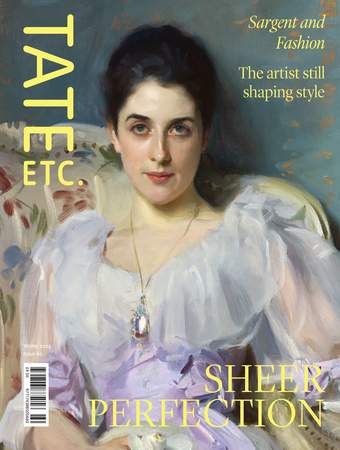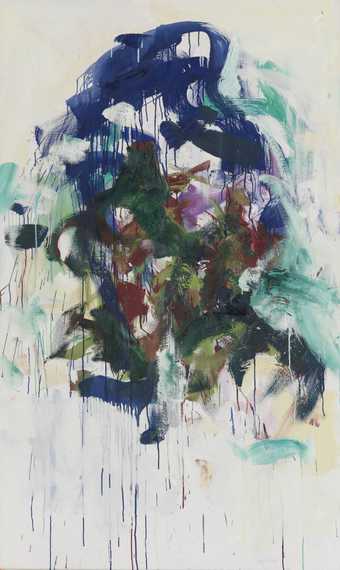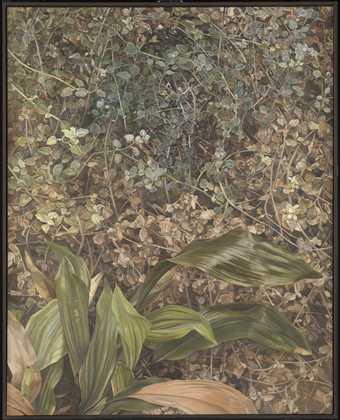
Joan Mitchell
Two Sunflowers 1980
© Estate of Joan Mitchell. Collection mPRIMAE (LVMH / Fondation Louis Vuitton)
Artist Jadé Fadojutimi provides a poetic response to Joan Mitchell’s abstract composition
Joan Mitchell's work resonates with the ethereal qualities of life. Although some of her titles might suggest a connection with nature and landscape in particular, one could also explore how they highlight our distance with reality; or our experience with seeing itself, which makes the works invigorating in the context of abstract painting.
When looking at Two Sunflowers, the title of this painting is our first invitation. Already suggesting a relationship with a familiar entity through language. One might question how the painting’s conversation with the viewer might change in the absence of written language. However, the exciting element to witness in this abstract work is its ability to evoke a relatable experience and go beyond it. Delving into a perspective of seeing by indulging in a brief moment of interaction and transforming it into a prolonged visitation.
In this case it’s the nuance of the sunflower and the infatuation with its palette. Comprising mainly of yellow and green, our eyes wander into the weather of this familiar subject matter that is lifted by pockets of lilac, browns and blues. A seasoned language of explosive metaphorical motives of space. One that has a poetic relationship with how nature can possess more than its physical frame and infect its surrounding environment.
When looking at one of her paintings, I like to imagine the movement that has gone into a work on view. How the artist’s body not only leaves its presence through mark making, but also how the artist creates linear and non-linear movements as her body dances upon the surface, suggesting a sunflower to be an overall climate. As though her hands have become a second pair of feet elaborately expressing and trapping life, and its emotive experience, in the marks left on the canvas.
An athletic performance, often filled with intuitive gestures and pace that resonate with a romantic facet that nature embodies itself. Seemingly translating her own body into a visual score that is far from chaos, and instead one that is in tune with its final inevitable composition through its composure. This energy abstracts the materiality of reality itself, dissolving and diluting figurative forms into anything but mere marks; but instead monumental relationships and conversations with everyday environments.
Mitchell’s painting language empowers the climate of its existence rather than just our literal relationship with sunflowers themselves. The nuance of the sunflower as an idea, and all based on the pretence that sunflowers are yellow.
Painter Pam Evelyn sees a story of life and death in Mitchell’s pair of colossal canvases
Two Sunflowers is painting in full bloom. It’s a mystery as to what confidence and invention could conceive such vibrations. A suspension of light, a lift and weightless untangling. At the base, dark brown tones act like roots grounding the composition’s heights. A sense of depth or distance is carved out through the mass of marks. Their vigour discloses a devotion to the tragedy of the fleeting perfection of a flower in bloom. It’s life and death on a pair of canvases.
When Mitchell made this work, she was living in Vétheuil, France, a small commune on the River Seine where Claude Monet had lived 100 years before. Her studio was grounded in a landscape made famous by the impressionists. Within her marks you can, per- haps, read the abundant nature of her surroundings, though she would often shut them out while working – a reflection, I think, of her intuition to make expressive paintings that were not too bound by place.
Mitchell didn’t look for easy solutions. Her paintings are orchestrated boundlessly in a tumultuous chant. Mitchell’s uninhibited brushwork is reliant on both precision and imbalance, a sense of elegance born out of risk. Every painting has been made under huge levels of scrutiny, while still retaining a natural, effortless lucidity. This can only be the consequence of a painter who never allowed the studio to become a site of complacency.
There is a sense of ruthless necessity in Mitchell’s art, too. She has a matter-of-fact way of dealing with paint, leaving no room for anything to feel too trying or too planned. The workings-out left to stand evident, she exposes and values every stage embod- ied in the paintings’ makeup. Built-up marks hold a mischievous threat, like a towering thundercloud.
In Two Sunflowers, light arrives under a scumble. Sometimes it peeks through, making some marks act in silhouette. At other times it bellows through in refracting jumps. Mitchell crafts light richly – it is a clarity within which harsh shadows also exist. What registers, then, looking at this painting, is a sensibility that can also be felt in the air, in the weather of every day. These paintings are like lungs containing a vast inhalation of mortality.
Two Sunflowers is included in a display of Joan Mitchell’s work at Tate Modern until 14 April 2024. Loans courtesy of the Fondation Louis Vuitton, Paris.
Jadé Fadojutimi is an artist based in London. Her painting I Present Your Royal Highness 2018 was purchased with funds provided by Anders and Yukiko Schroeder in 2019.
Pam Evelyn is a painter living and working in London.




